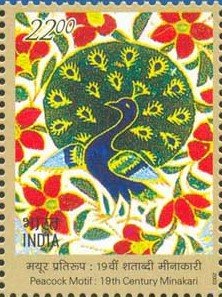Peacock Motif 19th-century Indian Minakari

Technical Data
| Stamp Set | Early French and Indian Art |
|---|---|
| Date of Issue | November 28, 2003 |
| Denomination | Rs.22 |
| Perforation | comb 13 x 13½ |
| Printer | Calcutta Security Printers Ltd |
| Watermark | No Watermark |
| Colors | Multicolor |
| Catalog Codes |
Michel IN 2001 Stamp Number IN 2040b Yvert et Tellier IN 1766 Stanley Gibbons IN 2176 WADP Numbering System - WNS IN058.03 |
| Themes | Art | Birds | Jewelery | Joint Issues | Peacocks |
Table of Contents
Commemorative Stamp Set: Peacock Motif – 19th-Century Indian Minakari
Design Elements
- The stamp features a 19th-century peacock motif, intricately crafted in the Minakari style. This traditional Indian art form uses enameling with bright colors and fine detailing, reflecting the richness of Mughal-era craftsmanship.
- The peacock, with its vibrant feathers, is surrounded by floral and vine patterns, symbols commonly found in Indian art.
- The colors are bold and vivid, including emerald green, turquoise blue, and ruby red, characteristic of the Minakari tradition. The peacock’s feathers are rendered with exquisite detail, showcasing the craftsmanship of Jaipur artisans.
Cultural and Historical Significance
- The peacock has been a symbol of grace, beauty, and pride in Indian culture for centuries. In the Mughal period, it was often used in royal jewelry and decoration, symbolizing royalty and divinity.
- Minakari, the art of enameling, was refined under Mughal patronage, where artisans perfected their techniques to adorn imperial thrones, jewelry, and ceremonial items.
- This stamp highlights the traditional craftsmanship of India, paying tribute to the artisans of Jaipur who have kept this ancient technique alive for generations.
Usage
- This stamp could be used to celebrate India’s rich cultural heritage, especially in relation to traditional crafts and fine arts.
- It would be issued during events like Indian Independence Day, Crafts Festivals, or in conjunction with diplomatic collaborations celebrating Indian art and culture.
Importance of the Commemorative Stamp Set
- The Peacock Minakari motif underscores India’s profound contribution to global art and jewelry design, while also preserving the history of Mughal-era craftsmanship.
- The stamp promotes the continuing legacy of Indian artisans, many of whom are engaged in traditional Minakari work, especially in Jaipur.
Example of the Stamp Design
- The peacock, centered on the stamp, has its tail fanned out in a display of vibrant, jewel-like feathers, with Minakari floral patterns flowing around it.
- The background features a rich gold frame, echoing the style of royal Mughal jewelry and artifacts. The peacock itself is detailed with emeralds and rubies, representing traditional Minakari color schemes.
The commemorative stamp set might include:
- A first-day cover showcasing additional Minakari motifs, with a brief history of the Mughal period’s artistic influence on Indian enamel work.
- A detailed information booklet on the Minakari process, highlighting its journey from the Mughal courts to its modern-day preservation in Jaipur.
Significance
- The peacock in Indian culture represents immortality, beauty, and wisdom—all qualities prized by ancient Indian rulers and artists.
- By showcasing the Minakari tradition, this stamp honors India’s artistic and cultural continuity, celebrating the skilled artisans who continue to practice and preserve this intricate craft.
